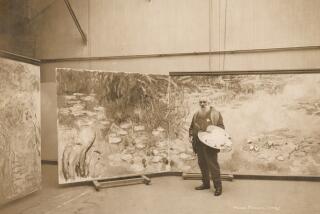‘Tiepolo Pink’ by Roberto Calasso
- Share via
Tiepolo Pink
Roberto Calasso
Translated from the
Italian by Alastair McEwen
Alfred A. Knopf: 320 pp., $40
The 18th century Venetian painter Giovanni Battista Tiepolo is hardly a household name in the United States; to see his work in its fullness one has to visit Venice; Würzburg, Germany; and Madrid. There you find magnificent ceiling paintings and frescoes that rival Michelangelo’s. Tiepolo’s name has also become that of a fabric shade of pink, which explains the title of Roberto Calasso’s “Tiepolo Pink” -- the next best thing to visiting Europe and seeing the painter’s work.
Calasso is one of the most demanding and intoxicating critics writing today. His books include “The Marriage of Cadmus and Harmony,” “The Ruin of Kasch” and “Literature and the Gods.” And yet, the word “critic” does little justice to Calasso, whose sentences are rooted in a profound understanding of all the major literatures of the world.
Early in “Tiepolo Pink,” he throws down the gauntlet: “Tiepolo: the last breath of happiness in Europe. And like all true happiness, it was full of dark sides destined not to fade away, but to get the upper hand.” Providing a complete survey of Tiepolo’s work, Calasso is undeterred that the painter left no self-commentary. He is elegant in his generalizing and astonishing in his specifics.
Commenting on a painting of Antony and Cleopatra at the moment she is about to dissolve a priceless earring in a glass of vinegar, he writes: “Anthony represents the power that invades the world but he does not possess the two pearls. Only one of which is sufficient to vanquish him. What happens to the other? It was sawn in two -- and the two halves were attached to the ears of the statue of Venus in the Pantheon. There is decidedly something paltry about that Western Power, obliged to adorn one of its goddesses with two half pearls that the Oriental queen was prepared to swallow in a sip of vinegar.”
Beautifully illustrated, Calasso’s book centers on explicating -- while never presuming that his is a definitive version -- the Capricci and the Scherzi, two series of etchings packed with magicians, Magi, beautiful young men and women and a plethora of creatures, in particular snakes and owls.
Calasso writes in a style that evokes a deeply compelling novel, especially when he teases out the proliferation of snakes. Of course, he starts from the Garden of Eden before moving on to the rain of snakes in Pharaoh’s time. “Moses’s gesture when he brandished a bronze serpent and told the murmuring Jews to look at it,” he writes, “was a gesture that marked the discovery that evil can be cured by its image. . . . It was the discovery of the image, of its healing power. It is one of the supreme Jewish paradoxes that this discovery was made by he who would be remembered and celebrated as the enemy of images . . .”
Calasso pushes his insight into an intriguing engagement with Tiepolo’s work. “Salvation through looking which the Fathers of the Church would ignore because the only thing that truly concerned them about the story of the brazen serpent was the prefiguration of the Cross was recognized by a painter before any theologian . . . hence the serpents: horror, fascination, perhaps even revelation.”
Finally, he describes one of Tiepolo’s last paintings, “The Rest on the Flight Into Egypt”: “Mary, Joseph, the child and the donkey can barely be seen in a corner. They are anonymous extras, absorbed in the landscape. The vision is still to come.”
Attentive readers might recall Calasso quoting the French reactionary Joseph de Maistre, “I have read millions of witticisms about the ignorance of the ancients who saw spirits everywhere: it seems to me that we who see them nowhere are much more foolish.”
McGonigle is the author of “The Corpse Dream of N. Petkov” and “Going to Patchogue.”
More to Read
The biggest entertainment stories
Get our big stories about Hollywood, film, television, music, arts, culture and more right in your inbox as soon as they publish.
You may occasionally receive promotional content from the Los Angeles Times.









